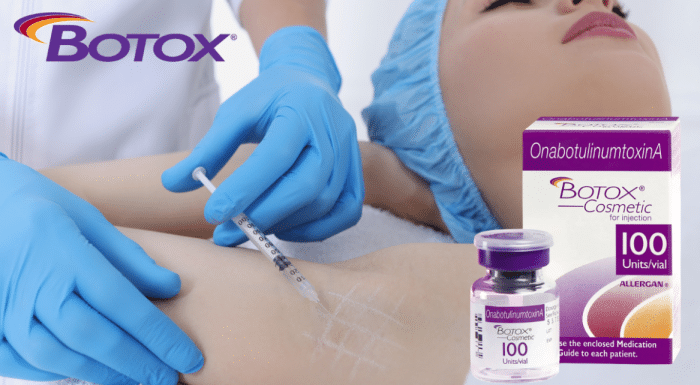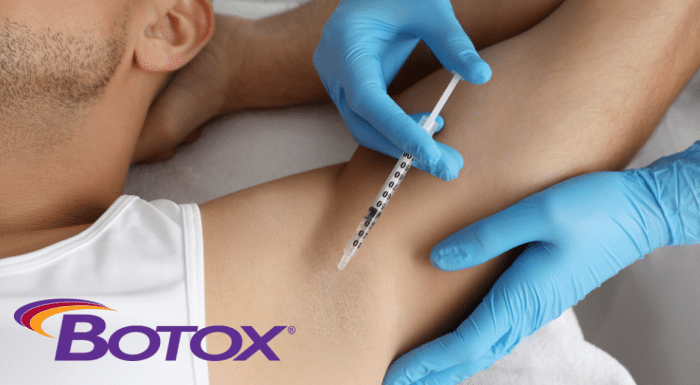
Botox: Not Just For Wrinkles – How It Can Combat Excessive Sweating
David Fuller
Last Updated On: August 15, 2024
According to the International Hyperhidrosis Society, Botox has received Food and Drug Administration approval as a treatment for excessive sweating (hyperhidrosis), which impacts nearly 15.3 million Americans. This endorsement positions Botox as an ally in combating the discomfort and challenges associated with hyperhidrosis.
Though commonly associated with cosmetic enhancements, Botox’s role in alleviating excessive sweating remains relatively under the radar. This treatment offers hope for individuals seeking to reclaim their confidence, which excessive sweating has undermined.
This article will explore how Botox functions on the skin’s surface and targets the sweat glands beneath, relieving and restoring normalcy for those with hyperhidrosis.
Key Takeaways
- Botox is an FDA-approved, effective treatment for hyperhidrosis that blocks sweat gland nerve signals, offering significant relief.
- Using Botox for excessive sweating improves quality of life by reducing social anxiety and restoring interaction confidence.
- The treatment involves a quick injection process with effects lasting 4 to 14 months, requiring consideration of potential side effects and professional consultation.
- Alternatives to Botox include topical antiperspirants, oral medications, iontophoresis, microwave therapy, and surgery, each with unique benefits and drawbacks.
Understanding Hyperhidrosis

As we explore the effectiveness and considerations of using Botox for hyperhidrosis, many individuals may have Botox questions and answers that are crucial for making an informed decision. Below, we delve into the process, benefits, and potential side effects to provide a comprehensive understanding.
What is hyperhidrosis?
Hyperhidrosis is characterized by excessive sweating exceeding the normal amount required for regulating body temperature. It significantly impacts individuals, causing them to sweat more than usual, not just during physical exertion or in hot environments but also in regular and relaxed settings. This condition can lead to feelings of social isolation and withdrawal as individuals may avoid physical contact and social situations due to the fear of body odor and visible sweating.
Primary vs. Secondary Hyperhidrosis
There are two main types of hyperhidrosis: primary (focal) hyperhidrosis and secondary (generalized) hyperhidrosis.
- Primary Hyperhidrosis: This type is often inherited and begins in childhood, worsening with puberty, especially in females. It is usually localized to specific areas such as the underarms, palms, face, scalp, and feet. The exact cause of primary hyperhidrosis is unknown. Still, it’s thought to be related to overactivity of the sympathetic nervous system, which controls sweating.
- Secondary Hyperhidrosis: Unlike primary hyperhidrosis, secondary hyperhidrosis has identifiable causes and is often a symptom of another condition or a side effect of medication. Various factors, including certain types of cancer, endocrine disturbances, infections, and the use of some medications, can trigger it. Secondary hyperhidrosis tends to be more generalized, affecting larger areas of the body.
Impact on Daily Life
Hyperhidrosis can affect individuals’ daily lives, mental health, and social well-being. The constant concern over excessive sweating can lead to changes in routine, avoidance of everyday actions like lifting arms or shaking hands, and relinquishing activities once enjoyed to prevent embarrassment.
Complications such as skin infections, skin changes (e.g., paleness, discoloration, cracks, or wrinkles), and maceration (soft, moist skin) can also impact the individual’s quality of life.
Botox as a Treatment for Hyperhidrosis
This treatment provides a way for individuals who have hyperhidrosis to regain confidence and comfort in their daily lives, free from the worry of excessive sweating.
How Botox Works to Combat Excessive Sweating
Botox is a recognized treatment for hyperhidrosis. It works by blocking the nerve signals stimulating the sweat glands, reducing sweat production in treated areas. The treatment involves small injections under the skin, generally described as causing minimal discomfort. The reduction in sweating becomes noticeable within a few days, with the full effects evident in about two weeks.
Areas of the Body That Can Be Treated with Botox Injections
Botox injections can be administered in several areas prone to excessive sweating, including:
- Hands
- Feet
- Under the breasts
- Head
- Face
These targeted treatments can provide significant relief from the discomfort and social impact of hyperhidrosis.
Effectiveness and Duration of Botox Treatment
Botox has proven to be a quick, effective, and relatively painless method for excessive sweating. The procedure typically takes 15 to 30 minutes, and patients can resume their daily activities immediately afterward. The results vary among individuals but generally last about 4 to 6 months. When the effects begin to wane, follow-up treatments can maintain the reduction in sweating.
Botox injections for hyperhidrosis are considered safe, with side effects being minor and temporary, like localized pain or bruising at the injection sites.
The Treatment Process

This comprehensive approach ensures that patients undergoing Botox treatment for hyperhidrosis are well-informed, comfortable with the procedure, and satisfied with the outcomes. It underscores the importance of selecting a qualified, experienced provider to ensure the highest safety and efficacy standards.
Consultation and Assessment
The journey to treating hyperhidrosis with Botox begins with a consultation with a qualified healthcare provider. This crucial step involves a comprehensive discussion about your symptoms, the impact of hyperhidrosis on your daily life, and your medical history. The goal is to assess the severity of your condition and determine whether Botox is the most appropriate treatment option for you.
This pre-treatment assessment may also include questions about any previous treatments you’ve tried and a discussion about your expectations from Botox treatment. It’s an opportunity to address any concerns or questions, ensuring you’re fully informed about the procedure, its potential benefits, and any risks involved.
Botox Injection Procedure
The Botox injection process for hyperhidrosis is quick, taking 20 to 45 minutes, and involves administering Botox beneath the skin using a fine needle. The number of injections varies with the area’s size and severity. To ease discomfort, local anesthetic or ice may be used. Patients can resume normal activities immediately, with no significant downtime required.
Post-treatment Care and Follow-up
Post-treatment care for Botox injections for hyperhidrosis involves avoiding strenuous activity for a day to prevent Botox spread, causing bruising or swelling. Massaging the treated areas should also be avoided for a few days. Results typically begin to show within 2 to 7 days, with full effects evident after two weeks. The effects can last 4 to 14 months, and follow-up treatments might be needed.
Follow-up care is essential for the best outcome and addressing any concerns.
Benefits of Botox for Hyperhidrosis
Botox for hyperhidrosis offers a transformative solution for individuals suffering from excessive sweating. This FDA-approved treatment has been proven safe and effective, making it a highly sought-after option for those looking to manage their symptoms and regain confidence in their daily lives.
Improved Quality of Life
Hyperhidrosis, or excessive sweating, goes beyond physical discomfort—it can significantly impact one’s daily life and emotional well-being. Botox for hyperhidrosis offers long-lasting relief, reducing excessive sweating for up to six months. This treatment minimizes the daily negative impacts of the condition, such as constantly worrying about sweat marks or changing clothes frequently, thus significantly improving the quality of life for those affected.
Reduced Social Anxiety and Embarrassment
Hyperhidrosis leads many individuals to experience social anxiety and embarrassment, significantly impacting their confidence in social and professional settings. Botox treatments can reduce sweating by 82%- 87% in targeted areas such as underarms, hands, feet, and even the face.
This reduction in sweat production can alleviate the fear of visible sweat marks and body odor, allowing individuals to engage more freely in social interactions and activities without worrying about embarrassment.
Long-term Relief from Excessive Sweating
Unlike topical solutions that offer temporary relief, Botox provides a more durable solution to excessive sweating. A single treatment can relieve excessive sweating for four to twelve months, with some patients reporting effects lasting up to 14 months. This long-term relief can drastically reduce the need for daily use of antiperspirants or other temporary measures, making Botox a convenient and effective option for managing hyperhidrosis.
Moreover, the procedure is quick, often taking less than 15 minutes, and involves minimal downtime, allowing patients to return to their daily activities immediately.
Considerations and Potential Side Effects of Botox for Hyperhidrosis
Choosing the right treatment for hyperhidrosis involves considering the severity of the condition, the desired duration of relief, potential side effects, and individual health factors. Botox offers a safe and effective option for many.
Who is a Suitable Candidate for Botox Treatment?
Botox treatment for hyperhidrosis is recommended for individuals with focal hyperhidrosis—excessive sweating limited to specific areas such as the underarms, palms, or soles. It’s typically advised as a second-line treatment, considering it after over-the-counter and prescription antiperspirants have been tried without success.
Suitable candidates are generally those aged 18 and older looking for a long-term solution to manage excessive sweating. However, certain conditions like pregnancy, breastfeeding, neurological disorders, and active skin infections at the potential injection site may contraindicate Botox use.
Common Side Effects and Risks
While Botox is FDA-approved and considered safe for the treatment of hyperhidrosis, there are potential side effects and risks associated with the procedure. Common side effects are typically localized to the injection site. They may include soreness, bruising, or mild swelling, which usually subside within a few days. In rare instances, patients might experience muscle weakness in the treated area, which is temporary.
More severe side effects could include difficulty swallowing, speaking, or breathing if the botulinum toxin spreads to areas beyond the treatment site. Therefore, it’s crucial to have the treatment administered by a qualified healthcare professional to minimize risks.
Alternative Treatment Options
For those who may not be suitable candidates for Botox or prefer exploring other options, several alternative treatments are available for managing hyperhidrosis. These include:
- Topical Antiperspirants: Over-the-counter or prescription-strength antiperspirants containing aluminum chloride.
- Oral Medications: Anticholinergic drugs can reduce sweating but may have side effects like dry mouth and blurred vision.
- Iontophoresis: A procedure that uses electricity to turn the sweat glands off temporarily.
- Microwave Therapy: Destroys sweat glands in the underarms using thermal (heat) energy.
- Surgery: Procedures like endoscopic thoracic sympathectomy (ETS) can permanently reduce sweating in certain areas but come with risks of compensatory sweating in other body parts.
Each treatment option has its benefits and drawbacks. The choice should be made in consultation with a healthcare provider who can assess the severity of the hyperhidrosis and recommend the most appropriate treatment based on individual needs and health conditions.
Conclusion
Botox is an efficacious and FDA-approved treatment for individuals with hyperhidrosis. It offers a chance to significantly improve their quality of life by reducing excessive sweating. While it has potential side effects, the treatment process is quick, and the benefits can last several months. Patients are encouraged to seek treatment from experienced and qualified healthcare providers and explore alternative treatments if necessary.
The transformative potential of Botox for those dealing with hyperhidrosis underscores its value beyond cosmetic applications, marking it as a pivotal solution for enhancing personal well-being and social confidence.
About: Established in 2016, Med Supply Solutions stands out as a leading supplier of under eye and lip fillers, catering to medical professionals seeking reliable products such as Botox full results. Offering competitive pricing, they bolster practice profitability while ensuring ample resources. Each client benefits from a dedicated VIP sales agent, guaranteeing a seamless shopping journey for quality body contouring solutions at an excellent value.
FAQs
1. Is Botox treatment for hyperhidrosis safe?
Yes, Botox is FDA-approved and safe for hyperhidrosis treatment, with common side effects being minor and localized.
2. How long does the effect of Botox last for hyperhidrosis?
Botox effects for hyperhidrosis typically last 4 to 14 months, varying among individuals.
3. What body areas can be treated with Botox for excessive sweating?
Botox can treat excessive sweating in the underarms, palms, soles, forehead, and under the breasts.
4. How quickly can I expect to see results after receiving Botox injections for hyperhidrosis?
Results are noticeable within 2 to 7 days, with full effects evident after two weeks.
5. Will my health insurance cover Botox treatment for hyperhidrosis?
Coverage varies; some insurance plans may cover Botox for hyperhidrosis if deemed medically necessary.
References
International Hyperhidrosis Society. (n.d.). Botox®. Retrieved from https://www.sweathelp.org/hyperhidrosis-treatments/botox.html
MacDonald, D. (n.d.). It’s Not Just for Wrinkles: How Botox Can Treat Excessive Sweating. Retrieved from https://www.drmmacdonald.com/its-not-just-for-wrinkles-how-botox-can-treat-excessive-sweating/
Healthline. (n.d.). Botox for Sweating. Retrieved from https://www.healthline.com/health/botox-for-sweating
M Health Fairview. (n.d.). Botox for Excessive Sweating: How Does It Work? Retrieved from https://mhealthfairview.org/blog%2Fbotox-for-excessive-sweating-how-does-it-work
Mayo Clinic. (n.d.). Botox. Retrieved from https://www.mayoclinic.org/tests-procedures/botox/about/pac-20384658
Carbon World Health. (n.d.). Stop Excessive Sweating with Botox. Retrieved from https://www.carbonworldhealth.com/blog/stop-excessive-sweating-with-botox
Mayo Clinic Dermatology. (n.d.). Not Just for Wrinkles: Botox Injections and Hyperhidrosis. Retrieved from https://www.mayoralderm.com/not-just-for-wrinkles-botox-injections-and-hyperhidrosis/
International Hyperhidrosis Society. (n.d.). Botox. Retrieved from https://www.sweathelp.org/hyperhidrosis-treatments/botox.html
Products
Cart
Log In
Newsletter
Subscribe for exclusive offers and updates on new arrivals
Share feedback at:
Working Hours
MON - SUN 9AM to 6PM EST
The Most Popular Brands
Med Supply Solutions
Support
Secure checkout is guaranteed with full adherence to PCI DSS payment standards.
Products listed here are guaranteed authentic and manufacturer-sourced.
Pay easily with trusted providers


Copyright 2025. Med Supply Solutions